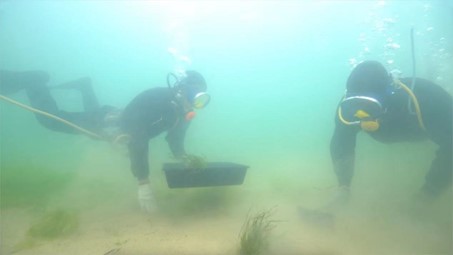IMTA under climate change
Physiological and ecosystemetic studies under a commercial IMTA aquaculture environmental background
Summary
People’s Republic of China has been the world largest aquaculture producer for decades, and the commercial scale integrated multi-trophic aquaculture (IMTA) conducted in Sanggou bay has provided an effective background environment for several aquaculture-related research projects. To explore sustainable aquaculture production, the research group of ‘Ecological Farming in Coastal Area’ at Yellow Sea Fisheries Research Institute, Chinese Academy of Fishery Sciences (CAFS) continues to conduct studies from the individual scale to the ecosystem scale, to effectively and quantitatively describe the interaction between the cultured organisms and the background environment.
1. Physical responses of Pacific Oyster, Crassostrea gigas to the ocean acidification (OA) under farming conditions and the synergistic effects of integrated aquaculture shellfish-seaweed in response to OA
Ocean acidification is predicted to have significant implications for marine calcifying organisms. However, little is known about the physiological responses of Pacific oyster, Crassostrea gigas, to elevated pCO2 under natural fluctuations associated with a farm environment. Our study showed that elevated pCO2 levels decreased clearance rate, ingestion rate, absorption efficiency and oxygen to nitrogen ratio, while increasing oxygen consumption and ammonia-N excretion rates. These physiological responses of oysters spat resulted in a reduction in energy available for growth (scope for growth).
Seaweed can absorb ambient dissolved CO2 through photosynthesis, thus it has gained theoretical attention as a potential partner of bivalves in integrated aquaculture to help mitigate the adverse effects of OA. We modified the previous research with the presence and absence of kelp (Saccharina japonica), using in situ mesocosms. Our findings indicate that the presence of S. japonica in integrated aquaculture may help shield C. gigas from the negative effects of elevated seawater pCO2.
2. The carbonate system under the commercial scale aquaculture background, demonstrated with seasonal cruise results
The research group have conducted five cruises from May to September and studied temporospatial variations in the seawater carbonate system in the semi-closed Sanggou Bay. Our results showed that both kelp and bivalve farming induced significant spatiotemporal variations in the carbonate system within the bay. Altered carbonate systems by kelp farming may favor calcification of farmed bivalves and provide an essential refuge for these species during the future ocean acidification.
3. Large-scale artificial cultivation and transplantation technology of Eelgrass under the background of commercial IMTA in Sanggou bay

Seagrass beds are one of the typical coastal ecosystems, with extremely high primary productivity and ecological service value. The current restoration strategies mostly use natural adult plants as transplant donors or direct seeding for restoration. It is imperative to explore a sustainable restoration strategy that considers the protection of natural seagrass resources and efficient restoration.
This study adheres to the technical route of artificially cultivating seedlings as transplant donors. The research includes: (1) the large-scale cultivation technology of eelgrass seedlings and (2) development of a modular resto ration technology with artificially cultivated seedlings as transplant donors.
4. Optimization and standalization of the IMTA practice with eco-farming principle and equipment
Shellfish aquaculture can accelerate the turnover of phytoplankton to reduce the eutrophication and play carbon sink role. Seaweeds aquaculture, which can reduce nutrient loadings to the environment from fed species aquaculture, has not been attractive in many countries as algal products typically have a low value. It is well known that combining different species in aquaculture systems or applying proper aquaculture methods and managements could provide more profit and have concomitant ecological benefits.

We optimized the longlines interval, buoy size and the kelp density and use new facilities for ropes connection to improve work efficiency. The kelp density was reduced 37%. The triploid oyster was cultured together with kelp. The same time, we built the suitable weight ecological anchor (2.38 tons) under the long-line facilities to attract sea cucumber underneath. In the end, the individual weight of kelp was 974.65g, dry production was 4631kg/ha. The wet weight of triploid oyster was 40.85% higher than the ordinary oyster. The sea cucumber biomass of IMTA area and oyster monoculture area were 418 kg/ha and 262kg/ha, its production improved 59%.
5. Ecosystem modelling with aquaculture organisms involved based on hydrodynamic information.
A hydrodynamic model with a horizontal resolution of 1000m were established in the Yellow Sea and Bohai Sea based on the Regional Ocean Modelling System, and the model results offered boundary condition for finer modeling in Sanggou bay. The ecosystem model NORWECOM was introduced with the collaboration with Institute of Marine Research, Norway, for the simulation of ecosystem processes in Sanggou Bay. By further introducing individual growth models of farmed organisms and population dynamics processes, the research group strives to reproduce the interaction between cultured organisms and natural environment during the aquaculture period based on model data with sufficient spatial and temporal resolution.
Some early modelling results showed that the current aquaculture practice, with an oyster farming density of 50 ind/m2 and a kelp stocking density of 5 ind/m2 was a balanced choice of seed cost, management labor cost and profit, which is based on decades of practical experience. With the improvement of the model system and the accumulation of observation data, the ecosystem model can be conducive to the sustainable development of large-scale aquaculture in Sanggou bay and similar systems.
For more information, please contact linfan@ysfri.ac.cn.
References
Jiang, W., Wang X., Rastrick SPS, et al.. Effects of elevated pCO2 on the physiological energetics of Pacific oyster, Crassostrea gigas, ICES Journal of Marine Science, 2021, 78(7): 2579-2590
Jiang, Z., Jiang, W., Rastrick SPS, et al. The potential of kelp Saccharina japonica in shielding Pacific oyster Crassostrea gigas from elevated seawater pCO2 stress. Frontiers in Marine Science, 2022 (Accepted)
